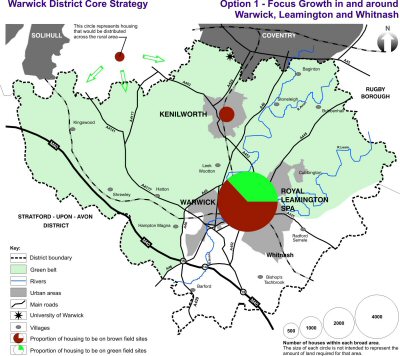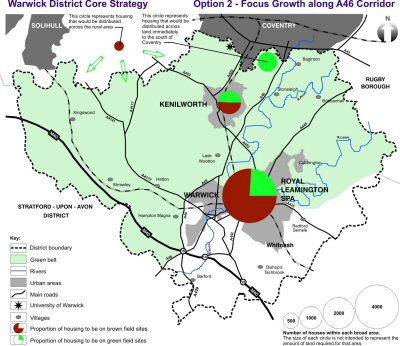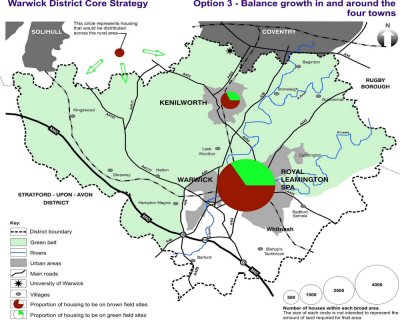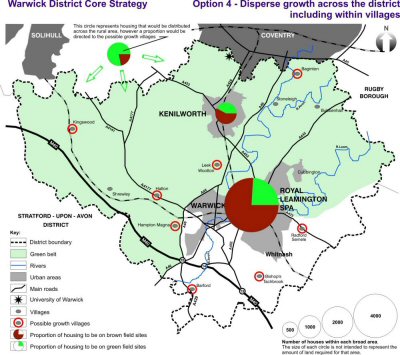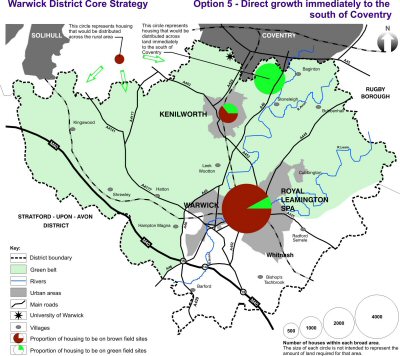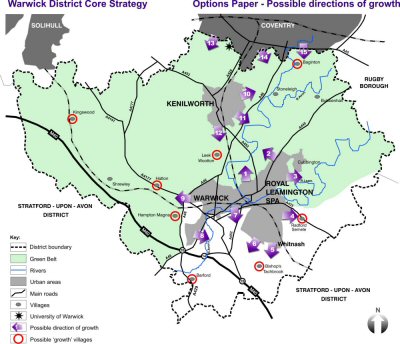4. Options for growth in Warwick District
We now need to consider how growth can be accommodated within the district. We have done this in three ways.
- Firstly, we have considered what factors should influence the options which we are putting forward.
- Secondly, we have identified a range of options for public consultation.
- Thirdly, we have begun to consider the implications of these options on broad areas and sites within the district.
The factors influencing our choice of options
We consider that the following should inform our choice of options:-
- We have used the growth figures shown in section 2 above as the basis for our options. We have also assumed that there will be capacity within our towns to absorb a significant proportion of this growth. This will need to come from brown field sites including buildings that can be converted.
- In view of this, some green field development (probably on the edge of towns) will be inevitable and the options need to look at this. As we do this, please note that not all countryside within Warwick District is in the Green Belt. (The plans later in this Paper which accompany the options show the current broad extent of Green Belt in Warwick District.) We have decided, for the purposes of this consultation, not to exclude land within the Green Belt from consideration. However, where Green Belt land is considered, the aim will be to maintain a proper separation between towns and to avoid coalescence between, for example, Leamington and Kenilworth, or Kenilworth and Coventry.
- We have tried to identify all “reasonable” options, however we have not attempted to identify every site or area which may come forward.
| Question 2: |
Do you agree with the factors which have influenced our choice of options? |
Proposing a range of options for public consultation
In the light of the above factors, we have identified a range of different options about which we would welcome your comments. These options are:-
| Option 1 | Focus growth in and around Warwick, Leamington and Whitnash |
| Option 2 | Focus growth along the A46 corridor |
| Option 3 | Balance growth in and around the four towns |
| Option 4 | Disperse growth across the district including within villages |
| Option 5 | Direct growth immediately to the south of Coventry |
These options are now described in more detail on the following pages.
Option 1: Focus growth in and around Warwick, Leamington and Whitnash
| Overview |
This option seeks to focus growth within and around the edge of Warwick, Leamington and Whitnash |
What does it mean?
- Warwick, Leamington Spa and Whitnash will absorb most new development in the district. Green field sites around the edges of the towns will be required for this. These sites may be within or outside of the Green Belt.
- The only development within Kenilworth will be on brown field land within the town.
- Elsewhere within the rural area, only development to meet local needs will be permitted.
|
Advantages
- Green field urban extensions would allow for new facilities and services to be master planned and for best use to be made of existing infrastructure where appropriate. It would also be able to make best use of existing public transport.
- There would be greater opportunity to provide a mix of housing to meet local needs and particularly to deliver higher levels of affordable housing.
- Developer contributions could help fund infrastructure and facilities.
|
Disadvantages
- Significant development on green field sites (possibly including land currently within the Green Belt) would be inevitable. There may be a need to amend current Green Belt boundaries.
- There would be additional pressure on existing infrastructure and services however there may be the opportunity to improve these through new investment funded by development.
- Growth in the rural area would be restricted to meeting identified local needs.
- Opportunities for further development within Kenilworth to meet any needs within the town would be limited to those which can be delivered on brown field sites.
- This option would be likely to increase the need for people to travel.
|
Option 2: Focus growth along the A46 corridor
| Overview |
This option directs any green field sites that are required towards those locations where there is easy access to the A46 trunk road and the Leamington – Coventry railway line |
What does it mean?
- Green field development will be focussed on those areas where there is easy access to the A46 trunk road and the Leamington – Coventry railway line.
- Green Belt land to the north and west of Warwick, the north of Leamington, the east of Kenilworth and the south of Coventry may be needed for development.
- Elsewhere within the rural area, only development to meet local needs will be permitted.
|
Advantages
- Green field urban extensions would allow for new facilities and services to be master planned and for best use to be made of existing infrastructure.
- There would be greater opportunity to provide a mix of housing to meet local needs and particularly to deliver higher levels of affordable housing.
- Further development in Kenilworth may help support the case to provide a new railway station for the town.
- This option would be able to make best use of existing public transport and improve existing road and rail-based routes.
- Developer contributions could be secured to fund infrastructure and facilities.
|
Disadvantages
- Significant development on green field sites would be inevitable.
- There would be a need to change current Green Belt boundaries.
- There would be additional pressure on existing infrastructure and services, particularly the A46, however there may be the opportunity to improve these through new investment funded by the development.
- The option may encourage additional road-based commuting along the A46.
- Growth in the rural area would be restricted to meeting identified local needs.
|
Option 3: Balance growth in and around the four towns
| Overview |
This option seeks to support balanced communities by balance new housing and employment development across the four towns |
What does it mean?
- This option seeks to support sustainable communities by creating a balance of new housing and employment development across the four towns in the district.
- Kenilworth, which has a very low employment base, will receive a significant amount of new employment development. This will need to use Green Belt land.
- The majority of the new housing will go to Warwick, Leamington and Whitnash, although some will be directed to Kenilworth. Green field sites will be required for this growth.
- Within the rural area, only development to meet local needs will be permitted
|
Advantages
- Green field urban extensions would allow for new facilities and services to be master planned and for best use to be made of existing infrastructure and public transport.
- Further employment opportunities in Kenilworth could help to reduce commuting and may help support the case to provide a new railway station for the town.
- There would be a greater opportunity to provide a mix of housing to meet local needs and particularly to secure higher levels of affordable housing.
- Developer contributions could be secured to fund infrastructure and facilities.
|
Disadvantages
- Significant development on green field sites (including land currently within the Green Belt) would be inevitable. This would have landscape, townscape and ecological implications. There would be a need to amend current Green Belt boundaries.
- There would be additional pressure on existing infrastructure and services however there may be the opportunity to improve these through new investment funded by the development.
- Growth in the rural area would be restricted to meeting identified local needs.
|
Option 4: Disperse growth across the district including within villages
| Overview |
This option seeks to balance housing and employment across the four towns, however some will be distributed between the larger villages within the rural area |
What does it mean?
- The need for new development would broadly be met across the four towns in accordance with the principles set out in option 3 above.
- However, some housing and employment growth would be promoted across the rural area above that which is required to meet local needs. This would be targeted towards the larger villages and settlements which have a wider range of services. It is suggested that these villages are Baginton, Barford, Bishops Tachbrook, Hampton Magna, Hatton Park, Lapworth (Kingswood), Leek Wootton, and Radford Semele.
- Green field sites would be required including land within the Green Belt.
|
Advantages
- Green field extensions would allow for new facilities and services to be master planned and for best use to be made of existing infrastructure and public transport.
- Increased development in the larger villages would increase population size which may help to protect and improve village services.
- Further employment opportunities in Kenilworth could help to reduce commuting and may help support the case for a new railway station for the town.
- There would be a greater opportunity to provide a mix of housing to meet local needs and particularly to secure higher levels of affordable housing.
- Developer contributions could be secured to fund infrastructure and facilities.
|
Disadvantages
- Significant green field development would be inevitable. Green Belt land would need to be released around Kenilworth and within/adjacent to some villages.
- There would be additional pressure on existing infrastructure and services however there may be the opportunity to improve these through new investment funded by the development.
- Levels of growth in the larger villages would be greater than that needed to meet local needs. This would increase levels of commuting between rural and urban areas and put more pressure on rural roads.
- This option would not accord with current local and regional planning policy which seeks to focus growth into urban areas.
|
Option 5: Direct growth immediately to the south of Coventry
| Overview |
This option would direct green field site development towards the southern edge of Coventry in the first instance and after this towards the next closest location |
What does it mean
- New housing and employment development will be directed towards the southern edge of Coventry. Green Belt land will be required to meet this need.
- Where development cannot be accommodated immediately to the south of Coventry, it will be directed to the closest urban area. This means some additional development on the edge of Kenilworth and possibly also some on the north side of Warwick and Leamington.
- Elsewhere within the rural area, only development to meet local needs will be permitted.
|
Advantages
- Green field urban extensions would allow for new facilities and services to be master planned and for best use to be made of existing infrastructure and public transport.
- Housing and employment would be close to Coventry, benefiting from infrastructure within the city boundary.
- Development may assist in achieving the objective of supporting the further growth and regeneration of Coventry.
- Further employment opportunities in Kenilworth could help to reduce commuting and may help support the case to provide a new railway station for the town.
- There would be a greater opportunity to provide a mix of housing to meet local needs and particularly to secure higher levels of affordable housing.
- Developer contributions could be secured to fund infrastructure and facilities
|
Disadvantages
- Any development would have a greater relationship with Coventry than with towns within Warwick District, and therefore may not meet needs within our communities as effectively.
- There would be additional pressure on the highway network along the A46 and A45.
- Significant development on green field sites would be inevitable. Villages such as Baginton could be directly affected.
- There would be a need to change current Green Belt boundaries to the south of Coventry and around Kenilworth.
- There would be additional pressure on existing infrastructure and services, however there may be the opportunity to improve these through new development.
- Growth in the wider rural area (outside of those areas immediately south of Coventry) would be restricted to meeting identified local needs.
|
Are there any other options?
As well as the five options above, we have also considered two further options, however we have decided not to pursue these are further.
Option 6: Focus growth within the four towns
What is this option?
This is similar to option 1, however in this option all reasonable opportunities will be taken to maximising the number of homes that are built on brown field sites within the towns. This will mean building at higher densities in certain locations.
Why are we not taking this option further?
- The option would see more development within the towns that any other options. This would impact upon air and noise pollution and CO2 emissions owing to increased congestion. It would also put additional pressure on existing infrastructure.
- The option would make it more difficult for the district to meet its need for a mix of housing types and sizes.
- There would be greater pressure on existing services such as education, community and medical facilities.
- This option is considered less likely to promote a strong and sustainable economy in relation to other options.
Option 7: Create a new settlement in the rural area
What is this option?
In this option, a new settlement would be created somewhere within the rural area to accommodate all growth that cannot be comfortably accommodated within the urban areas. This would (approximately) have 2,700 new homes and 10 hectares of employment land.
Why are we not taking this option further?
- A new settlement would have a significant impact on the local environment and wildlife.
- It would increase the need to travel across the district as a whole. This would give rise to increased air and noise pollution and CO2 emissions.
- There would be little opportunity for new education, health and other community facilities in the settlement to benefit the wider community.
| Question 3: |
Which of the seven options (if any) do you prefer? |
| Question 4: |
Do you agree that we should not pursue options 6 and 7 any further? |
| Question 5: |
Are there any other options you would wish us to consider? (This could include an option which draws on elements within the options we have put forward.) |
Where may this development go?
Whilst it is not the purpose of this “options” stage to identify specific sites where development would take place, it is important that we begin to think about where this growth could be directed. We have identified 15 broad “directions of growth” and these are shown on the plan overleaf.
As stated earlier, please note that the Council is not, at this stage, expressing a preference for any of these “directions of growth”. At the present time, we are simply exploring all “reasonable” options.
The possible directions of growth are the following.
- Land north of Milverton, Leamington Spa
- Land north of Lillington, Leamington Spa
- Land east of Lillington (Campion Hills area), Leamington Spa
- Land east of Sydenham, Leamington Spa and west of Radford Semele
- Land south of Whitnash
- Land south of Warwick Gates, Warwick
- Land west of Europa Way (including land south of Gallows Hill), Warwick
- Land east of Stratford Road, Warwick
- Land west and north west of Warwick
- Land north east of Kenilworth
- Land south east of Kenilworth (Thickthorn)
- Land south of Kenilworth
- Land south of Coventry – Kirby Corner
- Land south of Coventry – Finham
- Land south of Coventry – Baginton
Click on the map below to view a detailed version in a new window
| Question 6: |
Do you support any of the possible directions of growth set out above? |
| Question 7: |
Do you object to any of the possible directions of growth set out above? |
| Question 8: |
Do you wish to suggest any other possible directions of growth? |
